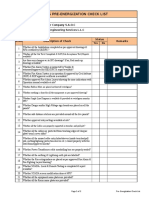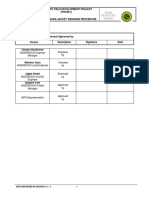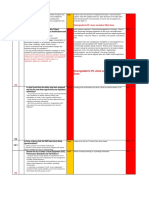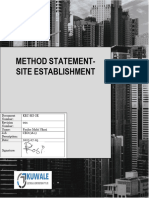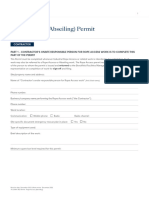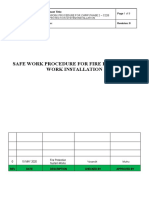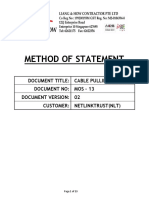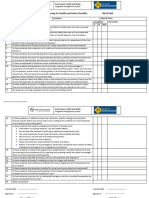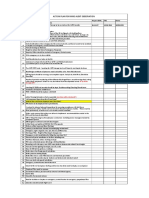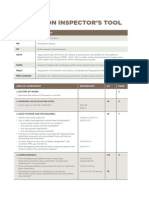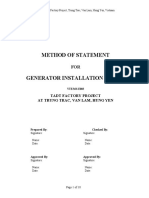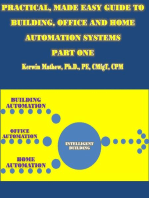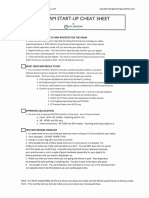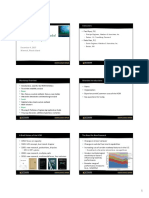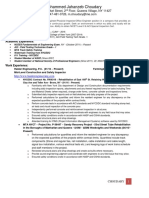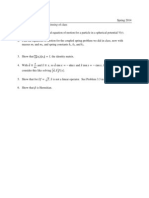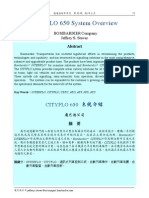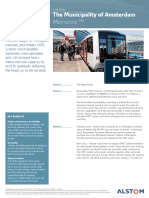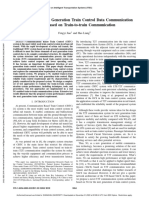Pages From Safety Bulletin 2007-1 - Rev 8 Sept 30 2014
Pages From Safety Bulletin 2007-1 - Rev 8 Sept 30 2014
Uploaded by
Mohammed Jahanzeb ChoudaryCopyright:
Available Formats
Pages From Safety Bulletin 2007-1 - Rev 8 Sept 30 2014
Pages From Safety Bulletin 2007-1 - Rev 8 Sept 30 2014
Uploaded by
Mohammed Jahanzeb ChoudaryOriginal Description:
Original Title
Copyright
Available Formats
Share this document
Did you find this document useful?
Is this content inappropriate?
Copyright:
Available Formats
Pages From Safety Bulletin 2007-1 - Rev 8 Sept 30 2014
Pages From Safety Bulletin 2007-1 - Rev 8 Sept 30 2014
Uploaded by
Mohammed Jahanzeb ChoudaryCopyright:
Available Formats
Capital Program Management
Safety Bulletin 2007-1, Rev. #8, 9/30/14
Track Safety & Flagging Verification Checklist
PRIOR TO THE
START OF WORK
CHECK OFF
YES
NO
N/A
1 Was a properly completed G.O. and/or flagging request with supporting documentation
submitted in compliance with request procedures and deadlines?
2 Are any Emergency Alarm Boxes (EA) / Emergency Telephones (ET) listed on the Trouble
Ticket Report in the work area(s)? (Access via TENS at
http://itapps1.transit.nyct.com/TroubleTicket/ ; User Name & Password: cpmso)
a. If EA is listed on the outage report:
i Is the work to be performed under flagging? If yes, NOT allowed to work.
ii
Is the work under G.O. with power off? If yes, allowed to work ONLY if the nearest ET
works or other communication to RCC exists. (See DOS Procedure 2.1)
iii Is the work under G.O. with power on? If yes, NOT allowed to work.
Locate nearest ET to each work zone and verify that it is working (check for dial tone See DOS Procedure 2.1)
3 Has the CPM office in-charge coordinated with other G.O.s that may be working in the area
(during planning and on-site; piggybacking)?
b.
4 Prior to each work shift, did the Contractor's / Consultant's safety representative check that all
their personnel have the track training and task training needed to perform the work, including
their qualification cards (e.g. track safety, welding, other certifications)?
5 Did the Contractor's / Consultant's safety representative conduct a job-specific safety meeting
or Toolbox Safety Talk to include review of :
a.
b.
c.
d.
flagging arrangements
proper clearing up procedures
location and operation of nearest EA/ET
safe job site access and egress
e. job related hazards and mitigation procedures
6 Are all required / necessary environmental metering equipment on site and available for
immediate use?
Have the environmental meters been calibrated? Noise and emission levels of equipment
been determined and OSHA required noise suppression provided? Carbon Monoxide
a.
(CO) - 35ppm, Nitrogen Dioxide (NO2) -1ppm, Noise variable refer to OSHA,
CFR1926.52.
7 Did the Engineer-in-Charge (EIC) verify with the RCC that the track has been secured for
G.O. access to the trackway (i.e. power off and switches blocked & clamped)?
a. Record the following:
i name & pass # of RCC representative spoken to:
ii time of power off:
AM/PM
iii time switches blocked & clamped:
AM/PM
8 Are all personnel (including NYCT/CPM) wearing proper PPE (e.g.: vest, helmet, eye
protection, safety shoes, rubber and leather protective gloves for installing alarm box, etc.)
and have in-date training / qualification cards in their possession?
9 Did you discuss job-specific safety rules and applicable Policy Instructions with all NYCT/CPM
employees before establishing flagging / implementing the G.O.?
10 If work area is in CBTC mainline territory, has employee in charge of flagging contacted the
RCC to establish the work zone, inhibit Automatic Train Operation (ATO) and set primary and
auxiliary traffic to same direction?
Did the EIC verify that the CBTC work zone is properly established per Item 10 and that
a. workers are properly notified of the exact limits of established CBTC work zone?
DURING WORK
SHIFT
11 If barriers are used to isolate the work area from an active track, were they approved and
properly installed per the most recent Design Guidelines?
12 If used, are all components of the Temporary Tie Bumper in place? (2 red lights and/or flags,
chains/padlocks, portable trips, white bank of lights, & 7 rubber mat See CPM Safety
Bulletin 2005-3, latest revision)
COMPLETE PAGE 2
1
Capital Program Management
Safety Bulletin 2007-1, Rev. #8, 9/30/14
Track Safety & Flagging Verification Checklist (Cont)
DURING WORK
SHIFT
CHECK OFF
YES
NO
N/A
13 Did the EIC and the Contractor's / Consultant's safety representative conduct a job site
inspection prior to the start of the task and verify required equipment and safety devices (i.e.:
light, gas, & noise meters; rubber mats, temporary tie-bumper components) are on-site and in
good condition?
14 Have adequate clearance areas been identified and provided?
15 Is power ON? If yes, verify a. below.
a.
Are proper 3rd rail protective rubber mats used? (See DOS Procedure 6.0: required
length; must be Type1, Class 2; date stamped; not older than 18 months)
16 Is power OFF? If yes, verify a. & b. below.
a.
rd
Are there an adequate number of 3 rail alarm boxes in place at each work site? (Make
sure boxes are hooked up properly by each crew)
b. Have all 3rd rail alarm boxes been tested?
17 Are all work areas illuminated to 5 foot-candles (minimum)?
a. Was this verified using a calibrated light meter?
18 Is job site housekeeping satisfactory in accordance with the requirements for establishing the
BOX (work area between flags)?
AT THE END OF
WORK SHIFT
19 Has the work train been inspected prior to leaving the work site (i.e.: no overhanging material,
material not piled too high and in danger of falling off, material & equipment properly
secured)? - See NYCT P/I #2.8.0
20 If a test train has been requested, has the Contractor / Consultant been directed to remain
onsite to make corrections if needed?
21 If multiple shifts are involved, assure the new EIC has all required G.O. work information and
status, including piggybacking. Was this done?
22 Was the G.O. implemented / closed in accordance with PMG 123?
23 Was the "Track Safety & Flagging Verification Checklist" completed?
24 Are Safety Rule Dispute Resolution (SRDR) forms available?
DOS
RESPONSIBILITIES 25 Is the Joint Management/Union Safety Inspection Placard available?
26 Are "Flagger Position Illumination Lamps" required / in use? (Note: RTO-C has been issued
OSS approved portable lamps by CPM for this purpose. Flaggers are responsible to bring
them to site and for their use.
CONTRACT #:
LOCATION:
WORK SHIFT:
NAME/TITLE:
PMG 123 TRAINING
EXP. DATE:
TRACK SAFETY
TRAINING EXP.
DATE:
SIGNATURE:
DATE:
Revised 9/30/14
You might also like
- PTOE Refresher Course BookDocument188 pagesPTOE Refresher Course BookMohammed Jahanzeb ChoudaryNo ratings yet
- Method of Statement For MV&LV SwitchgearsDocument12 pagesMethod of Statement For MV&LV SwitchgearsUtku Can Kılıç100% (2)
- Updated Is 14489 Safety Audit Checklist EhsDocument10 pagesUpdated Is 14489 Safety Audit Checklist EhsUdhayakumar Venkataraman100% (10)
- March SHO Monthly ReportDocument6 pagesMarch SHO Monthly ReportNidurazi Ideris64% (11)
- Hse Audit Checklist SafetyDocument7 pagesHse Audit Checklist Safetysubhanmusadiq50% (2)
- Safety Bulletin 2007-1 - Rev 8 Sept 30 2014Document3 pagesSafety Bulletin 2007-1 - Rev 8 Sept 30 2014Mohammed Jahanzeb ChoudaryNo ratings yet
- Revised Site Audit TemplateDocument4 pagesRevised Site Audit TemplateLucian100% (2)
- Pre Energization Check List.Document2 pagesPre Energization Check List.shenbagaraman100% (2)
- Hazard Identification Risk Assessment and Risk ControlDocument7 pagesHazard Identification Risk Assessment and Risk ControlChowKC03100% (17)
- CBTC Communication Based Train ControlDocument18 pagesCBTC Communication Based Train ControlhiryanizamNo ratings yet
- 331 Ning B Ed Advanced Train Control Systems PDFDocument167 pages331 Ning B Ed Advanced Train Control Systems PDFbfoo_6100% (2)
- Safety Audit Checklist - Stringing ActivityDocument3 pagesSafety Audit Checklist - Stringing ActivitysAuRaBh100% (1)
- Method Statement For Plunge ColumnDocument17 pagesMethod Statement For Plunge Columnvikas100% (3)
- Jacket Weighing ProcedureDocument14 pagesJacket Weighing ProcedureBolarinwa100% (1)
- Brochure - Rolling Stock - Metropolis Metro - EnglishDocument8 pagesBrochure - Rolling Stock - Metropolis Metro - EnglishashokkdesignNo ratings yet
- Metro Line LRT Signalling Bid Evaluations and IntroductionDocument66 pagesMetro Line LRT Signalling Bid Evaluations and IntroductionElise StolteNo ratings yet
- ATS - Presentation - V4Document52 pagesATS - Presentation - V4WiilDiazNo ratings yet
- 0418MC 04.17.19 Form 25 CPM Flagging Checklist 28th STDocument3 pages0418MC 04.17.19 Form 25 CPM Flagging Checklist 28th STMohammed Jahanzeb ChoudaryNo ratings yet
- Method StatementDocument16 pagesMethod StatementMark FashNo ratings yet
- Falls ChecklistDocument4 pagesFalls ChecklistZainuddin Mohd DaminNo ratings yet
- SKD Esperanza GRST P2 Pending Items New PDFDocument7 pagesSKD Esperanza GRST P2 Pending Items New PDFThiban KumarNo ratings yet
- Kec - Method Statement - Site EstablishmentDocument4 pagesKec - Method Statement - Site EstablishmentvelisantshuntsheNo ratings yet
- 02 HeightDocument2 pages02 Heightravirebelstar007No ratings yet
- ICT Permit To Work Application - Rev 2021Document2 pagesICT Permit To Work Application - Rev 2021Fatma AlSuwaidiNo ratings yet
- Safety Audit Checklist - Tower ErectionDocument3 pagesSafety Audit Checklist - Tower ErectionsAuRaBhNo ratings yet
- Brookfield Properties - Rope Access (Abseiling) Permit - 20Document6 pagesBrookfield Properties - Rope Access (Abseiling) Permit - 20mugenthararaoNo ratings yet
- R 03 Lifting and Shifting Work PermitDocument3 pagesR 03 Lifting and Shifting Work PermitPRIYESH . K. PRIYANNo ratings yet
- SWP CHECKLISTS - Works at HeightsDocument2 pagesSWP CHECKLISTS - Works at HeightsSrinivas Dumpala HSENo ratings yet
- Site Survey WorkDocument24 pagesSite Survey WorkShehzad MeharNo ratings yet
- ChecklistsDocument12 pagesChecklistsGaurav GuptaNo ratings yet
- HSL - Safe Work ProcedureDocument9 pagesHSL - Safe Work ProcedureYuki SukarnoNo ratings yet
- Safe Work Practices Checklist On-Line Leak Sealing ServicesDocument3 pagesSafe Work Practices Checklist On-Line Leak Sealing ServicesAk RajaNo ratings yet
- Induction Motor DimentionDocument1 pageInduction Motor DimentionkumarNo ratings yet
- NLT (LH) Method of Statement (MOS)Document13 pagesNLT (LH) Method of Statement (MOS)chiat mingNo ratings yet
- TL - Powergrid Safety Checklist - Rev-2Document10 pagesTL - Powergrid Safety Checklist - Rev-2Raj Kiran GunduNo ratings yet
- WP056P Rev0Document12 pagesWP056P Rev0Mohamed Reda HusseinNo ratings yet
- Tunnel Transport & Plant ChecklistDocument3 pagesTunnel Transport & Plant Checklistvseem zahirNo ratings yet
- Method Statement For Scaffolding ActivitiesDocument8 pagesMethod Statement For Scaffolding ActivitiesMohsen KeramatiNo ratings yet
- Checklist For Working in Substations or Vicinity of Energized Panels-1Document1 pageChecklist For Working in Substations or Vicinity of Energized Panels-1Madhu Electricals & Engineering100% (1)
- 2 - RAMS Barry Galliford - Installation of Steel Structure Bottom Level Rev 0Document12 pages2 - RAMS Barry Galliford - Installation of Steel Structure Bottom Level Rev 0Christos TsaropoulosNo ratings yet
- Risk Assessment & Method Statement Example 1: TH STDocument19 pagesRisk Assessment & Method Statement Example 1: TH STAnonymous FmXEu2cHxKNo ratings yet
- Tunnel Planning For Health and Safety ChecklistDocument2 pagesTunnel Planning For Health and Safety Checklistvseem zahirNo ratings yet
- Action Plan For Mms Audit Observation: To Be Done Through EPRDocument13 pagesAction Plan For Mms Audit Observation: To Be Done Through EPRbalvantsinghNo ratings yet
- Ating Removal and OpenholeDocument7 pagesAting Removal and OpenholearunmirandaNo ratings yet
- SQF-RAMS-LIN-DR-01 - Installation of Drainage LinesDocument29 pagesSQF-RAMS-LIN-DR-01 - Installation of Drainage LinesAkshay DeepNo ratings yet
- Method Statement For Room Control UnitDocument14 pagesMethod Statement For Room Control UnitshareyhouNo ratings yet
- Instruction - Transport, Assembly and Disassembly of Terex Demag 400 Ton Crane CC 2400-1Document129 pagesInstruction - Transport, Assembly and Disassembly of Terex Demag 400 Ton Crane CC 2400-1Mariela Fernández Morey100% (1)
- SQF-RAMS-LIN-DR-02 - Installation of Condensate Drain Pipes.Document30 pagesSQF-RAMS-LIN-DR-02 - Installation of Condensate Drain Pipes.Akshay DeepNo ratings yet
- SPI HSE FR 01 Foundation ChecklistDocument1 pageSPI HSE FR 01 Foundation ChecklistChandan KumarNo ratings yet
- SPI HSE FR 01 Foundation ChecklistDocument1 pageSPI HSE FR 01 Foundation ChecklistChandan KumarNo ratings yet
- Excavations PDFDocument2 pagesExcavations PDFandresboy123No ratings yet
- Unit C Mock Exam - 8-6-2022 - AnswersDocument9 pagesUnit C Mock Exam - 8-6-2022 - Answersابو محمد عليNo ratings yet
- BPLD MPD EnglishDocument10 pagesBPLD MPD EnglishCao Xuan HopNo ratings yet
- SHE 68 - 9589 - Elevator Work PermitDocument2 pagesSHE 68 - 9589 - Elevator Work Permitciupcic100% (1)
- CONF-GD15 UNDERGROUND OVERHEAD CHECKLISTDocument2 pagesCONF-GD15 UNDERGROUND OVERHEAD CHECKLISTstephentNo ratings yet
- SQF-RAMS-LIN-EL-03 - Cable and Wire PullingDocument31 pagesSQF-RAMS-LIN-EL-03 - Cable and Wire PullingAkshay DeepNo ratings yet
- Method Statement For MV Panels and Accessories Unloading.: Project NameDocument12 pagesMethod Statement For MV Panels and Accessories Unloading.: Project NameSatish SharmaNo ratings yet
- 1.0 Execution Method Statement Preparatory Works: Documents YES NODocument1 page1.0 Execution Method Statement Preparatory Works: Documents YES NOMuhammed Shafeek K TNo ratings yet
- 08.procedure - Confined Space Entry and Rescue - PRO 08 - Rev 1Document8 pages08.procedure - Confined Space Entry and Rescue - PRO 08 - Rev 1Krishna Kumar SasidharanNo ratings yet
- Work Permit SystemDocument5 pagesWork Permit SystemSuresh PasumarthiNo ratings yet
- S.No. Environment& OH&S Issue Yes No N/A Remarks/corrective Action Needed A General Safety at SiteDocument2 pagesS.No. Environment& OH&S Issue Yes No N/A Remarks/corrective Action Needed A General Safety at SiteVishal Tiwari50% (2)
- WSD Field Safety Survey Check List - Rev. Jan. 01-23-20Document4 pagesWSD Field Safety Survey Check List - Rev. Jan. 01-23-20Myla AguadoNo ratings yet
- Method Statement (DKi 2024)Document2 pagesMethod Statement (DKi 2024)Noman AliNo ratings yet
- Hse Pssr Check List TopDocument10 pagesHse Pssr Check List Topghadrshenas1346No ratings yet
- GBBD MOS for Installation for P&S Sytem Rev 4 LTADocument91 pagesGBBD MOS for Installation for P&S Sytem Rev 4 LTAer.malaimuruganNo ratings yet
- Practical, Made Easy Guide To Building, Office And Home Automation Systems - Part OneFrom EverandPractical, Made Easy Guide To Building, Office And Home Automation Systems - Part OneNo ratings yet
- Ilil FF (T1.1,,"-U:, rp".#m3 (?!.,NDocument2 pagesIlil FF (T1.1,,"-U:, rp".#m3 (?!.,NMohammed Jahanzeb ChoudaryNo ratings yet
- Supplement Module 3 Traffic Operations Interrupted FlowDocument27 pagesSupplement Module 3 Traffic Operations Interrupted FlowMohammed Jahanzeb ChoudaryNo ratings yet
- Practice Exam 3 AM (C) SolutionsDocument31 pagesPractice Exam 3 AM (C) SolutionsMohammed Jahanzeb ChoudaryNo ratings yet
- Professional Traffic Operations Engineers Certification Program Refresher CourseDocument39 pagesProfessional Traffic Operations Engineers Certification Program Refresher CourseMohammed Jahanzeb ChoudaryNo ratings yet
- Img 20190810 0001Document1 pageImg 20190810 0001Mohammed Jahanzeb ChoudaryNo ratings yet
- HCM 6 Edition: A Guide For Multimodal Mobility Analysis: InstructorsDocument43 pagesHCM 6 Edition: A Guide For Multimodal Mobility Analysis: InstructorsMohammed Jahanzeb ChoudaryNo ratings yet
- Resume CE (Ins)Document2 pagesResume CE (Ins)Mohammed Jahanzeb ChoudaryNo ratings yet
- Lab Report: Phys-381 - Experiments in Modern PhysicsDocument13 pagesLab Report: Phys-381 - Experiments in Modern PhysicsMohammed Jahanzeb ChoudaryNo ratings yet
- Lab Report: Phys-381 - Experiments in Modern PhysicsDocument16 pagesLab Report: Phys-381 - Experiments in Modern PhysicsMohammed Jahanzeb ChoudaryNo ratings yet
- 2013 Scholarship PacketDocument12 pages2013 Scholarship PacketMohammed Jahanzeb ChoudaryNo ratings yet
- pp1 SWDocument1 pagepp1 SWMohammed Jahanzeb ChoudaryNo ratings yet
- AECOM GO - 14 Org Chart - 53rd ST - 6-3-16 To 6-6-16Document1 pageAECOM GO - 14 Org Chart - 53rd ST - 6-3-16 To 6-6-16Mohammed Jahanzeb ChoudaryNo ratings yet
- Handout 4 2011Document14 pagesHandout 4 2011Mohammed Jahanzeb ChoudaryNo ratings yet
- HW 2Document1 pageHW 2Mohammed Jahanzeb ChoudaryNo ratings yet
- Findings and Recommendations - National Drought Policy Commission Environmental Issues GroupDocument44 pagesFindings and Recommendations - National Drought Policy Commission Environmental Issues GroupMohammed Jahanzeb ChoudaryNo ratings yet
- Communications Based Train Control (CBTC)Document29 pagesCommunications Based Train Control (CBTC)v2brother63% (8)
- M Sher - ResumeDocument2 pagesM Sher - Resumem sherNo ratings yet
- Train-Ground Communication in CBTC Based On 802.11b Design and Performance ResearchDocument5 pagesTrain-Ground Communication in CBTC Based On 802.11b Design and Performance ResearchSailajaUngatiNo ratings yet
- Survey On Driverless Train Operation For Urban Rail Transit SystemsDocument8 pagesSurvey On Driverless Train Operation For Urban Rail Transit SystemsPatrik GalambosNo ratings yet
- UITP-Statistic Brief-Metro-A4-WEB - 0 PDFDocument6 pagesUITP-Statistic Brief-Metro-A4-WEB - 0 PDFCarlos Redondo BenitezNo ratings yet
- Ieee 2014 Project List by Spectrum Solutions PondicherryDocument159 pagesIeee 2014 Project List by Spectrum Solutions PondicherryRaushan Kumar SinghNo ratings yet
- Bombardier CityfloDocument14 pagesBombardier CityfloBiju KmNo ratings yet
- Alstom - Atlas Trackside - Brochure - enDocument7 pagesAlstom - Atlas Trackside - Brochure - enkadagysNo ratings yet
- Irse News No 151 Dec 09Document32 pagesIrse News No 151 Dec 09Chandrasekhar BabuNo ratings yet
- The Municipality of Amsterdam: MetropolisDocument2 pagesThe Municipality of Amsterdam: MetropolishichamkabelNo ratings yet
- CBTC BrochureDocument4 pagesCBTC BrochureRahul KumarNo ratings yet
- A 5G Enabled Next Generation Train Control Data Communication System Based On Train-To-Train CommunicationDocument5 pagesA 5G Enabled Next Generation Train Control Data Communication System Based On Train-To-Train CommunicationwangxipowerfulNo ratings yet
- Nyct Rules Regulations 2016 OptimizedDocument329 pagesNyct Rules Regulations 2016 OptimizedDavidNo ratings yet
- Comparative Analysis of US and European Approaches On Risk Analysis in Railway SignalingDocument21 pagesComparative Analysis of US and European Approaches On Risk Analysis in Railway SignalingpoketupiNo ratings yet
- What Is Unattended Train Operation (UTO) ?Document18 pagesWhat Is Unattended Train Operation (UTO) ?machinmayNo ratings yet
- Normas InternacionalesDocument120 pagesNormas InternacionalesOmarNo ratings yet
- STANDARD SPECIFICATIONS For MetroliteDocument10 pagesSTANDARD SPECIFICATIONS For MetroliteVendran BruslinNo ratings yet
- Alstom - UrbalisDocument7 pagesAlstom - UrbalisFx EtaixNo ratings yet
- CBTC Solutions - Thales Seltrac IS PDFDocument7 pagesCBTC Solutions - Thales Seltrac IS PDFPaul KwonNo ratings yet
- Bombardier Transportation CountryBrochure Australia enDocument8 pagesBombardier Transportation CountryBrochure Australia enRizki Fajar NovantoNo ratings yet
- Singapore DTL Signalling by Joana Lee (Siemens Pte LTD) 18th Nov 2016Document23 pagesSingapore DTL Signalling by Joana Lee (Siemens Pte LTD) 18th Nov 2016Rizky Harry SungguhNo ratings yet
- A Study On The Application of Train To Train Communication in Train Control SystemsDocument6 pagesA Study On The Application of Train To Train Communication in Train Control SystemsrajimuruganNo ratings yet
- URBALIS May14 RevDocument9 pagesURBALIS May14 RevenfrspitNo ratings yet
- Upgrading Metro Systems With CBTCDocument10 pagesUpgrading Metro Systems With CBTC202134022430No ratings yet
- (Railway) Signaling System - Catalog - EN - 202106Document98 pages(Railway) Signaling System - Catalog - EN - 202106sylver_manNo ratings yet







